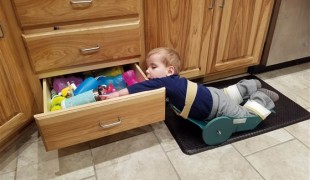- 3345
- 317
- 6
- 3
- 0
- Help Ukraine
About the solution
“[CRI] is a rowing program that’s basically trying to cater to people who are Olympians, but also paralympians and children and people with disabilities. They had a variety of projects for us to work on. I worked on a project that created a glove for people who had weak grip strength or things like that. So they can keep rowing even if their hand gives out. You’re making something with your hands, which is a skill not a lot of people our age have. You’re taking a piece of wood or PVC pipe, or aluminium and you’re turning it into something that’s useful and that’s part of what’s kept me in engineering”, she explained.
The student loved it so much that she thought about taking an independent study for the next semester. That’s when she spoke with Rabbi Bodian who had a potential idea for her. She told her all about a friend of hers, Colby, that suffers from thrombocytopenia with absent radius (or TAR Syndrome, which causes one's arms to develop without the radius).
Rabbi Bodian suggested that Sarah could build something to help him. The student agreed and started talking to Colby, who told her that he had been using a tool that his dad made him — a four-foot wooden pole with a hook on one end and a tool hook on the other. But has he explained, the problem with this device was it was too big to carry around. And he and his family had been looking for years for a solution.
Sarah went through several mockups to come up with a prototype that would meet Colby’s needs, using different materials and with different collapsing and expanding mechanisms.
“I had to create a device that was sturdy, that could extend and collapse to fit in like a backpack and something that he was comfortable using out and about. The point of mockups and sketch models are you do them even if you don’t think it’s going to work just to help you think about it. I thought about something with a button you can press on to collapse like a crutch or a cane, but that can be a hassle and a half. Then I thought about a tent pole but it wouldn’t be as stable. Then I remembered something that has actually been used in the Wellesley Engineering lab for CRI a few years back. It was a successful project. It was made for grabbing the handles of an erg, a rowing machine, for people who can’t reach that far”, the student observed.
After that, she just had to search and making the necessary materials.
When the project was finished, Sarah mailed it to Colby who told her he was really excited and was using this new tool instead of the old one.
Sarah will make improvements according to Colby’s feedback.
“It was a really intense and difficult process but it’s so rewarding to see him using it. It’s really made it all worth it”, the inventor expressed.
Adapted from: https://bit.ly/2GePMb4
This solution shall not include mention to the use of drugs, chemicals or biologicals (including food); invasive devices; offensive, commercial or inherently dangerous content. This solution was not medically validated. Proceed with caution! If you have any doubts, please consult with a health professional.
DISCLAIMER: This story was written by someone who is not the author of the solution, therefore please be advised that, although it was written with the utmost respect for the innovation and the innovator, there can be some incorrect statements. If you find any errors please contact the patient Innovation team via info@patient-innovation.com
-
-
657
-
0
-
9906

Dad creates device to help 2-year-old son with spina bifida
CAREGIVING
BODY BALANCE: Maintaining body balance
Spinal Cord and Nerve Root Disorders
Assistive Daily Life Device (to help ADL)
Strategy/Tip
Gait abnormalities (e.g., walking difficulties, unsteady gait)
Difficulty coordinating movements
Stiffness or rigidity (difficulty moving)
Paralysis of the legs and lower body
Muscle weakness
Loss of balance
Cognitive impairment
Restoring mobility
Maintaining Balance and Mobility
Preventing (Vaccination, Protection, Falls, Research/Mapping)
Caregiving Support
Medical Genetics
Neurology
Neurosurgery
Pediatrics
United States
-
-
-
353
-
0
-
3770

Hip & co- a mum's invention for hip dysplasia
CAREGIVING
BODY BALANCE: Maintaining body balance
STANDING UP: Standing up from a seated position
WALKING WITH A WALKING AID: Walking with a walking aid
WALKING: Walking
Hip Dysplasia
Assistive Daily Life Device (to help ADL)
Walking Aid (wheelchair/walker/crutches)
Difficulty walking or moving
Muscle weakness
Limited range of motion
Muscle pain or stiffness
Loss of muscle coordination
Muscle cramps or spasms
Joint deformity
Joint redness or warmth
Swelling or inflammation
Difficulty bearing weight
Numbness or tingling in the extremities
Frequent falls
Joint pain or swelling
Restoring mobility
Managing pain
Promoting self-management
Preserving Organ Function
Recovering from Traumatic Injuries
Maintaining Balance and Mobility
Raise awareness
Caregiving Support
General and Family Medicine
Orthopedics
Pediatrics
Australia
-
-
-
286
-
0
-
3328

Teacher Alex Truesdell is Transforming Lives: Adaptive Design Association Revolutionizes Disability Solutions
CAREGIVING
Drawing
Painting
Playing
BODY BALANCE: Maintaining body balance
(SELF)-CARE: DRINKING: Drinking independently.
(SELF)-CARE: EATING: Eating independently.
MOVING IN A WHEELCHAIR: Moving using a wheelchair.
Playing an instrument
Studying
Blindness
Hand Deformity
Neuromuscular Disorders
Assistive Daily Life Device (to help ADL)
Walking Aid (wheelchair/walker/crutches)
Restoring mobility
Replacing lost limbs
Enhancing health literacy
Promoting self-management
Promoting inclusivity and social integration
To improve Treatment/Therapy
Preventing (Vaccination, Protection, Falls, Research/Mapping)
Raise awareness
Caregiving Support
General and Family Medicine
Internal Medicine
Orthopedics
Pediatrics
Physical Medicine and Rehabilitation
United States
-
 en
en